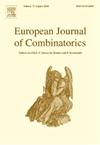On the Erdős–Tuza–Valtr conjecture
IF 0.9
3区 数学
Q1 MATHEMATICS
引用次数: 0
Abstract
The Erdős–Szekeres conjecture states that any set of more than points in the plane with no three on a line contains the vertices of a convex -gon. Erdős, Tuza, and Valtr strengthened the conjecture by stating that any set of more than points in a plane either contains the vertices of a convex -gon, points lying on a concave downward curve, or points lying on a concave upward curve. They also showed that the generalization is actually equivalent to the Erdős–Szekeres conjecture. We prove the first new case of the Erdős–Tuza–Valtr conjecture since the original 1935 paper of Erdős and Szekeres. Namely, we show that any set of points in the plane with no three points on a line and no two points sharing the same -coordinate either contains 4 points lying on a concave downward curve or the vertices of a convex -gon. The proof is also formalized in Lean 4, a computer proof assistance, to ensure the correctness of the proof.
关于厄尔多斯-图扎-瓦尔特猜想
厄尔多斯-塞克雷斯猜想指出,平面中任何超过 2n-2 个点的集合,只要没有三点在一条直线上,就包含一个凸 n 形的顶点。Erdős、Tuza 和 Valtr 强化了这一猜想,指出平面上任何超过 ∑i=n-ba-2n-2i 个点的集合要么包含凸 n 形的顶点,要么包含位于向下凹曲线上的 a 个点,要么包含位于向上凹曲线上的 b 个点。他们还证明了这一推广实际上等同于厄尔多斯-塞克斯猜想。我们证明了 Erdős-Tuza-Valtr 猜想自 Erdős 和 Szekeres 于 1935 年发表论文以来的第一个新案例。也就是说,我们证明了平面上任何 n-12+2 个点的集合,其中没有三个点在一条直线上,也没有两个点共享相同的 x 坐标,要么包含位于向下凹曲线上的 4 个点,要么包含凸 n 形的顶点。为了确保证明的正确性,还用 Lean 4 这一计算机证明辅助工具将证明形式化。
本文章由计算机程序翻译,如有差异,请以英文原文为准。
求助全文
约1分钟内获得全文
求助全文
来源期刊
CiteScore
2.10
自引率
10.00%
发文量
124
审稿时长
4-8 weeks
期刊介绍:
The European Journal of Combinatorics is a high standard, international, bimonthly journal of pure mathematics, specializing in theories arising from combinatorial problems. The journal is primarily open to papers dealing with mathematical structures within combinatorics and/or establishing direct links between combinatorics and other branches of mathematics and the theories of computing. The journal includes full-length research papers on important topics.

 求助内容:
求助内容: 应助结果提醒方式:
应助结果提醒方式:


